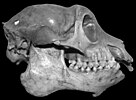Mesopropithecus was a lemur from Madagascar, slightly larger than any of those alive today, but one of the smallest that are known only from subfossil remains. This genus of the sloth lemur family Palaeopropithecidae includes the species M. dolichobrachion, M. globiceps, and M. pithecoides. All three species were primarily leaf-eaters, but also ate fruit and seeds. M. globiceps ate more seeds than M. pithecoides, and an analysis of the teeth of M. dolichobrachion suggests that it ate even more seeds; it also had distinctly longer arms. A recently discovered postcranial skeleton shows that Mesopropithecus had longer forelimbs than hindlimbs—a trait shared by all sloth lemurs. Remains of M. dolichobrachion have been found only in the north of the island, M. pithecoides in the south and west, and M. globiceps in the center. The genus died out after the arrival of humans on the island, probably through hunting, habitat destruction, or both. (Full article...)
